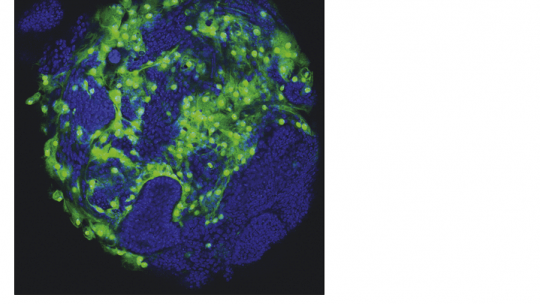Images
Participants



Contact

Researchers at IRB Barcelona reveal the capacity of epithelial-derived tumours to grow in the absence of a microenvironment.
Featured on the cover of the journal Proceedings of the National Academic of Sciences (PNAS), the study identifies the cell types and molecular mechanism involved in tumour initiation and growth.
The results of this study contribute to our understanding of the internal mechanisms of the tumour, which may provide a therapeutic target.
Researchers from the Development and Growth Control Laboratory at IRB Barcelona have identified the cell types and molecular mechanism responsible for the unlimited growth potential of epithelial tumours (carcinomas) and demonstrated that the growth of these tumours is independent of its microenvironment. “In epithelial tumours caused by chromosomal instability or loss of cell polarity, the interaction between two tumour cell populations drives malignant growth,” explains Marco Milán, ICREA Research Professor and head of the laboratory.
Published in the journal Proceedings of the National Academic of Sciences (PNAS) as a cover story of its 35 Issue, the study analyses solid tumours of epithelial origin in the fruit fly Drosophila melanogaster. “We have induced tumour development in two ways—by generating genomic instability and the loss of cell polarity. We have validated the causal relation between these two conditions—which are frequently observed in carcinomas—and the development of tumours,” explains Mariana Muzzopappa, first author of the study and postdoctoral fellow in the Development and Growth Control Lab.
Independent of the tumour microenvironment
To study the effect of the microenvironment on tumour development, the researchers examined tumour growth in the absence of adjacent cell populations, such as cells of the immune system or mesenchymal cells, which can act as a niche by supplying tumours with growth factors. The scientists observed that the tumour continued to grow in the absence of these two cell types.
Furthermore, they demonstrated that “the growth of epithelial tumours is dependent on activation of the JNK stress signalling pathway and that this pathway is intrinsically activated in the tumour, regardless of its microenvironment,” highlights Marco Milán.
Interactions between two tumour cell populations
The researchers have identified two functionally distinct cell populations within the tumour—one that proliferates and ones that does not—upon which internal growth mechanisms depend. “JNK is activated in a group of non-proliferating cells, namely those that show the highest degree of chromosomal instability or that have lost polarity. JNK triggers the expression of growth factors and makes those cells still in the epithelium to go on proliferating. The continued proliferation of these cells leads to an increase in chromosomal instability and the loss of epithelial polarity in the tumours. Consequently, the number of cells expressing growth factors rises. These cross-feeding interactions explain the unlimited growth potential of these epithelial tumours,” says Muzzopappa.
The mechanism of JNK activation differs depending on the tumour. “We have observed that tumours derived from chromosomal instability are induced by oxidative stress caused by ROS (reactive oxygen species), which triggers JNK. The mechanism in tumours that arise from the loss of cell polarity differs,” explains Marco Milán.
The results of this study shed further light on the causal relationship between chromosomal instability, loss of epithelial polarity and tumorigenesis and open new avenues for the search of therapeutic targets.
This study was supported by the Ministry of Economy, Industry and Competitiveness (MINECO) through ERDFs “A way to build Europe” and "la Caixa" Foundation PhD programme, that supports Lada Murcia PhD student.
Reference article:
Mariana Muzzopappa, Lada Murcia and Marco Milán
Feedback amplification loop drives malignant growth in epithelial tissues
PNAS (2017): doi: 10.1073/pnas.1701791114
(Written by: Llúcia Ribot)
See also Marco Milán's video "Meet Our Scientists" to know more about the research carried out in his laboratory:
About IRB Barcelona
Created in 2005 by the Generalitat de Catalunya (Government of Catalonia) and University of Barcelona, IRB Barcelona is a Severo Ochoa Centre of Excellence, a seal that was awarded in 2011. The institute is devoted to conducting research of excellence in biomedicine and to transferring results to clinical practice, thus improving people’s quality of life, while simultaneously promoting the training of outstanding researchers, technology transfer, and public communication of science. Its 25 laboratories and seven core facilities address basic questions in biology and are orientated to diseases such as cancer, metastasis, Alzheimer’s, diabetes, and rare conditions. IRB Barcelona is an international centre that hosts 400 employees and 32 nationalities. It is located in the Barcelona Science Park. IRB Barcelona forms part of the Barcelona Institute of Science and Technology (BIST) and the “Xarxa de Centres de Recerca de Catalunya” (CERCA).
About IRB Barcelona
The Institute for Research in Biomedicine (IRB Barcelona) pursues a society free of disease. To this end, it conducts multidisciplinary research of excellence to cure cancer and other diseases linked to ageing. It establishes technology transfer agreements with the pharmaceutical industry and major hospitals to bring research results closer to society, and organises a range of science outreach activities to engage the public in an open dialogue. IRB Barcelona is an international centre that hosts 400 researchers and more than 30 nationalities. Recognised as a Severo Ochoa Centre of Excellence since 2011, IRB Barcelona is a CERCA centre and member of the Barcelona Institute of Science and Technology (BIST).






